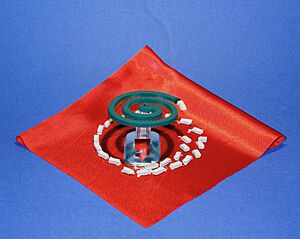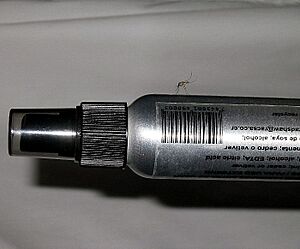Insect repellent facts for kids
An insect repellent (also commonly called "bug spray") is a substance applied to the skin, clothing, or other surfaces to discourage insects (and arthropods in general) from landing or climbing on that surface. Insect repellents help prevent and control the outbreak of insect-borne (and other arthropod-bourne) diseases such as malaria, Lyme disease, dengue fever, bubonic plague, river blindness, and West Nile fever. Pest animals commonly serving as vectors for disease include insects such as flea, fly, and mosquito; and ticks (arachnids).
Some insect repellents are insecticides (bug killers), but most simply discourage insects and send them flying or crawling away. Nearly any would be fatal upon reaching the median lethal dose, but classification as an insecticide implies death even at lower doses.
Contents
Common insect repellents
Common synthetic insect repellents
- Benzaldehyde, for bees
- Butopyronoxyl (trade name Indalone). Widely used in a "6-2-2" mixture (60% Dimethyl phthalate, 20% Indalone, 20% Ethylhexanediol) during the 1940s and 1950s before the commercial introduction of DEET
- DEET (N,N-diethyl-m-toluamide) the most common and effective insect repellent
- Dimethyl carbate
- Dimethyl phthalate, not as common as it once was but still occasionally an active ingredient in commercial insect repellents
- Ethyl butylacetylaminopropionate (IR3535 or 3-[N-Butyl-N-acetyl]-aminopropionic acid, ethyl ester)
- Ethylhexanediol, also known as Rutgers 612 or "6–12 repellent," discontinued in the US in 1991 due to evidence of causing developmental defects in animals
- Icaridin, also known as picaridin, Bayrepel, and KBR 3023 considered equal in effectiveness to DEET
- Methyl anthranilate and other anthranilate-based insect repellents
- Metofluthrin
- Permethrin is a contact insecticide rather than a repellent
- SS220 is a repellent being researched that has shown promise to provide significantly better protection than DEET
- Tricyclodecenyl allyl ether, a compound often found in synthetic perfumes
Common natural insect repellents
- Beautyberry (Callicarpa) leaves
- Birch tree bark is traditionally made into tar. Combined with another oil (e.g., fish oil) at 1/2 dilution, it is then applied to the skin for repelling mosquitos
- Bog myrtle (Myrica gale)
- Catnip oil whose active compound is Nepetalactone
- Citronella oil (citronella candles are not effective)
- Essential oil of the lemon eucalyptus (Corymbia citriodora) and its active compound p-menthane-3,8-diol (PMD)
- Lemongrass
- Neem oil
- Tea tree oil from the leaves of Melaleuca alternifolia
- Tobacco
Insect repellents from natural sources
Several natural ingredients are certified by the United States Environmental Protection Agency as insect repellents, namely catnip oil, oil of lemon eucalyptus (OLE) (and its active ingredient p-Menthane-3,8-diol), oil of citronella, and 2-Undecanone, which is usually produced synthetically but has also been isolated from many plant sources.
Many other studies have also investigated the potential of natural compounds from plants as insect repellents. Moreover, there are many preparations from naturally occurring sources that have been used as a repellent to certain insects. Some of these act as insecticides while others are only repellent. Below is a list of some natural products with repellent activity:
- Achillea alpina (mosquitos)
- alpha-terpinene (mosquitos)
- Andrographis paniculata extracts (mosquito)
- Basil
- Sweet basil (Ocimum basilicum)
- Breadfruit (Insect repellent, including mosquitoes)
- Callicarpa americana (beautyberry)
- Camphor (mosquitoes)
- Carvacrol (mosquitos)
- Castor oil (Ricinus communis) (mosquitos)
- Catnip oil (Nepeta species) (nepetalactone against mosquitos)
- Cedar oil (mosquitos, moths)
-
Celery extract (Apium graveolens) (mosquitos) In clinical testing an extract of celery was demonstrated to be at least equally effective to 25% DEET, although the commercial availability of such an extract is not known.
- Cinnamon (leaf oil kills mosquito larvae)
- Citronella oil (repels mosquitos) (contains insect repelling substances, such as citronellol and geraniol)
- Clove oil (mosquitos)
- D-Limonene (ticks, fleas, flies, mosquitoes, and other insects) (widely used in insect repellents for pets)
- Eucalyptus oil (70%+ eucalyptol), (cineol is a synonym), mosquitos, flies, dust mites In the U.S., eucalyptus oil was first registered in 1948 as an insecticide and miticide.
- Fennel oil (Foeniculum vulgare) (mosquitos)
- Garlic (Allium sativum) (Mosquito, rice weevil, wheat flour beetle)
- Geranium oil (also known as Pelargonium graveolens)
- Hinokitiol (ticks, mosquitos, larvae)
- Lavender (ineffective alone, but measurable effect in certain repellent mixtures)
- Lemon eucalyptus (Corymbia citriodora) essential oil and its active ingredient p-menthane-3,8-diol (PMD)
- Lemongrass oil (Cymbopogon species) (mosquitos)
- East-Indian lemon grass (Cymbopogon flexuosus)
- Linalool (ticks, fleas, mites, mosquitoes, spiders, cockroach)
- Marjoram (spider mites Tetranychus urticae and Eutetranychus orientalis)
- Mint (menthol is active chemical.) (Mentha sp.)
- Neem oil (Azadirachta indica) (Repels or kills mosquitos, their larvae and a plethora of other insects including those in agriculture)
- Nootkatone (ticks, mosquitoes and other insects)
- Oleic acid, repels bees and ants by simulating the "smell of death" produced by their decomposing corpses.
- Pennyroyal (Mentha pulegium) (mosquitos, fleas,) but very toxic to pets
- Peppermint (Mentha x piperita) (mosquitos)
- Pyrethrum (from Chrysanthemum species, particularly C. cinerariifolium and C. coccineum)
- Rosemary (Rosmarinus officinalis) (mosquitos)
- Spanish Flag (Lantana camara) (against Tea Mosquito Bug, Helopeltis theivora)
- Tea tree oil from the leaves of Melaleuca alternifolia
- Thyme (Thymus species) (mosquitos)
- Yellow nightshade (Solanum villosum), berry juice (against Stegomyia aegypti mosquitos)
Less effective methods
Some old studies suggested that the ingestion of large doses of thiamine (vitamin B1) could be effective as an oral insect repellent against mosquito bites. However, there is now conclusive evidence that thiamin has no efficacy against mosquito bites. Some claim that plants such as wormwood or sagewort, lemon balm, lemon grass, lemon thyme, and the mosquito plant (Pelargonium) will act against mosquitoes. However, scientists have determined that these plants are "effective" for a limited time only when the leaves are crushed and applied directly to the skin.
There are several, widespread, unproven theories about mosquito control, such as the assertion that vitamin B, in particular B1 (thiamine), garlic, ultrasonic devices or incense can be used to repel or control mosquitoes. Moreover, manufacturers of "mosquito repelling" ultrasonic devices have been found to be fraudulent, and their devices were deemed "useless" according to a review of scientific studies.
Alternatives to repellent
People can reduce the number of mosquito bites they receive (to a greater or lesser degree) by:
- Using a mosquito net
- Wearing long clothing that covers the skin and is tucked in to seal up holes
- Avoiding the outdoors during dawn and dusk, when mosquitos are most active
- Keeping air moving to prevent mosquitos from landing, such as by using a fan
- Wearing light-colored clothing (light objects are harder for mosquitos to detect)
- Reducing exercise, which reduces output of carbon dioxide used by mosquitos for detection
See also
- Fly spray (insecticide)
- Mosquito coil
- Mosquito control
- Mosquito net
- Pest control
- RID Insect Repellent
- Slug tape
- Chemical ecology





